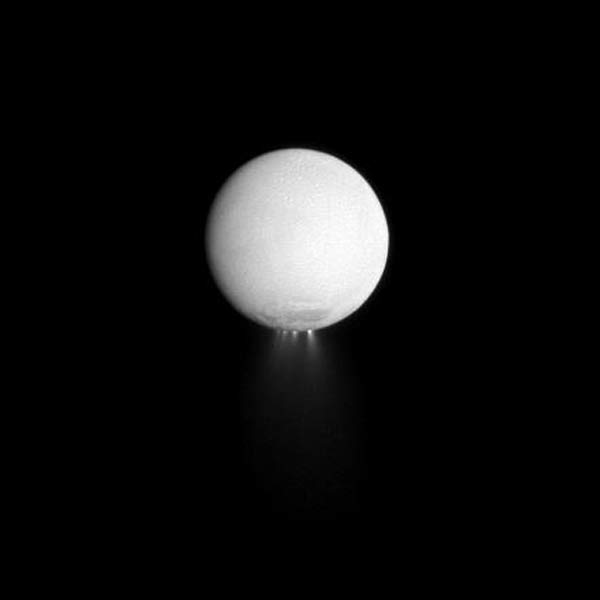Mystery Solved: Water on Saturn Comes From Icy Moon 'Rain'

An icy moon around Saturn is showering rain water onto its home planet, creating a vast halo of water vapor around the ringed world, a new study finds.
The discovery means that Enceladus, Saturn's sixth-largest moon, is the only moon in the solar system known to influence the chemical composition of its parent planet, researchers said. It also solves a 14-year mystery that had scientists puzzled over the source of the water in Saturn's upper atmosphere.
"There is no analogy to this behavior on Earth," said study leader Paul Hartogh, of the Max Planck Institute for Solar System Research in Germany, in a statement. "No significant quantities of water enter our atmosphere from space. This is unique to Saturn."
Enceladus has a frigid, icy surface but an active interior, particularly at its south pole. In this dynamic region, geothermal activity is concentrated at four trenches that are dubbed "tiger stripes," because of their distinctive surface markings. [Photos: The Rings and Moons of Saturn]
These fissures, which measure approximately 80 miles (130 kilometers) long and 1.2 miles (2 km) wide, form icy geysers that spew plumes of water vapor into space. Enceladus expels roughly 550 pounds (250 kilograms) of water vapor every second through its tiger stripe jets.
Another ring around Saturn
Observations from the European Space Agency's Herschel space observatory revealed that this water raining from Enceladus creates a doughnut-shaped ring of water vapor around Saturn.
Get the Space.com Newsletter
Breaking space news, the latest updates on rocket launches, skywatching events and more!
The total width of the water vapor ring is more than 10 times the radius of Saturn, yet it is only about one Saturn radius thick. Enceladus' elliptical orbit means that the moon's distance from Saturn varies as it travels around the ringed planet. But, Herschel's observations indicate that Enceladus' jets consistently replenish the water vapor ring throughout its orbit.
Despite the size of the ring, it had not been detected prior to now because water vapor is transparent to visible light, researchers said. Yet, Herschel's eyes, which are tuned to infrared wavelengths, were able to spot the curious feature.
"These are observations that only Herschel can make," said Göran Pilbratt, ESA Herschel project scientist, in a statement. "ESA's Infrared Space Observatory found the water vapor in Saturn’s atmosphere. Then NASA/ESA’s Cassini/Huygens mission found the jets of Enceladus. Now Herschel has shown how to fit all these observations together."
A mystery solved
Astronomers have known that Saturn's atmosphere holds traces of gaseous water in its deepest layers, but the presence of water in the planet's upper atmosphere had been a mystery. The phenomenon was first reported in 1997 by teams using ESA's Infrared Space Observatory, but until now, the source of the water was unknown.
Computer models based on the latest findings from Herschel estimate that between three to five percent of the water spewed by Enceladus ends up falling onto Saturn.
While most of Enceladus' rain is either lost in space, freezes on Saturn's rings, or potentially even falls onto the planet's other moons, what does reach the ringed planet is sufficient enough to explain the water in its upper atmosphere.
The water vapor is also responsible for the production of other chemical compounds bearing oxygen, such as carbon dioxide, scientists said.
Eventually, water in the planet's upper atmosphere will travel to lower levels, where the small amounts will condense into tiny clouds that are ultimately not observable, they added.
You can follow SPACE.com staff writer Denise Chow on Twitter @denisechow. Follow SPACE.com for the latest in space science and exploration news on Twitter @Spacedotcom and on Facebook.
Join our Space Forums to keep talking space on the latest missions, night sky and more! And if you have a news tip, correction or comment, let us know at: community@space.com.

Denise Chow is a former Space.com staff writer who then worked as assistant managing editor at Live Science before moving to NBC News as a science reporter, where she focuses on general science and climate change. She spent two years with Space.com, writing about rocket launches and covering NASA's final three space shuttle missions, before joining the Live Science team in 2013. A Canadian transplant, Denise has a bachelor's degree from the University of Toronto, and a master's degree in journalism from New York University. At NBC News, Denise covers general science and climate change.









